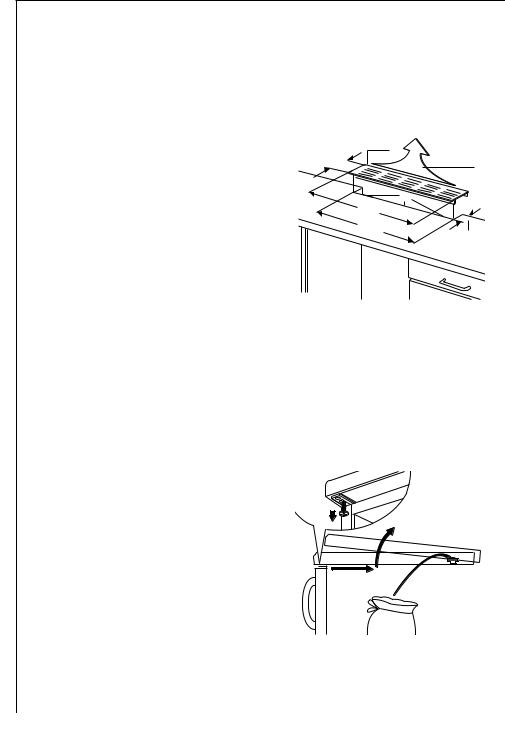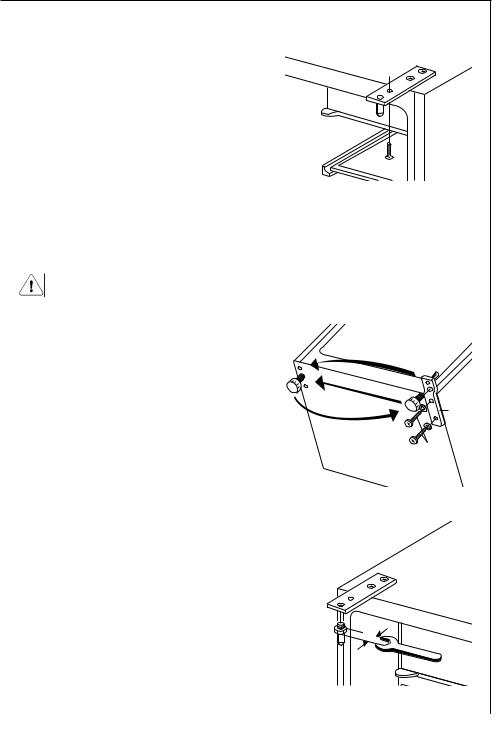AEG OEKOS.1444-6, OEKOS.1443-6TKCL Manual

ÖKO-SANTO
Tisch-Kühlautomat
Réfrigérateur automatique table top
Automatic Refrigerator
Gebrauchsanweisung
Mode d’emploi
Operating Instructions

Dear customer,
Before placing your new refrigerator/freezer into operation please read these operating instructions carefully. They contain important information for safe use, for installation and for care of the appliance.
Please keep these operating instructions for future reference. Pass them on to possible new owners of the appliance.
These operating instructions are for use with several technically comparable models with varying accessories. Please observe the notes which apply to your model.
Notes which are important for your safety or for the proper functioning of the appliance are stressed with a warning triangle and/ or with signal words (Warning!, Caution!, Attention!). Please observe the following carefully.
This symbol guides you step by step in the operation of the appliance.
Supplementary information regarding operation and practical applications of the appliance appear after this symbol.
Tips and notes concerning economical and environmentally sound use of the appliance are marked with the cloverleaf.
The operating instructions contain instructions for the correction of possible malfunctions by the user in the section "What to do if ...". If these instructions should not be sufficient, our customer service department is always available to you.
Printed on paper manufactured with environmentally sound processes.
he who thinks ecologically acts accordingly ...
50

Contents
Safety . . . . . . . . . . . . . . . . . . . . . . . . . . . . . . . . . . . . . . . . . . . . . . . . . . . . . . . 52 Disposal . . . . . . . . . . . . . . . . . . . . . . . . . . . . . . . . . . . . . . . . . . . . . . . . . . . . . . 54 Appliance Packaging Information. . . . . . . . . . . . . . . . . . . . . . . . . . . . . . . . 54 Disposal of old Appliances . . . . . . . . . . . . . . . . . . . . . . . . . . . . . . . . . . . . . 54 Remove transport safeguard . . . . . . . . . . . . . . . . . . . . . . . . . . . . . . . . . . . . . 54 Installation . . . . . . . . . . . . . . . . . . . . . . . . . . . . . . . . . . . . . . . . . . . . . . . . . . . 55 Installation Location . . . . . . . . . . . . . . . . . . . . . . . . . . . . . . . . . . . . . . . . . . 55 Your refrigerator needs air . . . . . . . . . . . . . . . . . . . . . . . . . . . . . . . . . . . . . 56 Detaching the worktop . . . . . . . . . . . . . . . . . . . . . . . . . . . . . . . . . . . . . . . . 56 Mounting under a continuous worktop . . . . . . . . . . . . . . . . . . . . . . . . . . . 57 Rehingeing the door . . . . . . . . . . . . . . . . . . . . . . . . . . . . . . . . . . . . . . . . . . 57 Changing over the freezer compartment door. . . . . . . . . . . . . . . . . . . . . . 58
Prior to Initial Start–Up . . . . . . . . . . . . . . . . . . . . . . . . . . . . . . . . . . . . . . . . 59 Electrical Connection . . . . . . . . . . . . . . . . . . . . . . . . . . . . . . . . . . . . . . . . 59 Plug socket . . . . . . . . . . . . . . . . . . . . . . . . . . . . . . . . . . . . . . . . . . . . . . . . 60
Description of the appliance . . . . . . . . . . . . . . . . . . . . . . . . . . . . . . . . . . . . 60 View of the appliance . . . . . . . . . . . . . . . . . . . . . . . . . . . . . . . . . . . . . . . . 60
Starting up and temperature regulation . . . . . . . . . . . . . . . . . . . . . . . . . . . 61
Interior Accessories . . . . . . . . . . . . . . . . . . . . . . . . . . . . . . . . . . . . . . . . . . . . 62 Storage shelves/wire trays. . . . . . . . . . . . . . . . . . . . . . . . . . . . . . . . . . . . . 62 VARIO glass storage shelf . . . . . . . . . . . . . . . . . . . . . . . . . . . . . . . . . . . . . 62 Correct storage. . . . . . . . . . . . . . . . . . . . . . . . . . . . . . . . . . . . . . . . . . . . . . . . 63 Freezing and storing frozen food . . . . . . . . . . . . . . . . . . . . . . . . . . . . . . . . . 63 Preparation of Ice Cubes . . . . . . . . . . . . . . . . . . . . . . . . . . . . . . . . . . . . . . . . 64 Defrosting . . . . . . . . . . . . . . . . . . . . . . . . . . . . . . . . . . . . . . . . . . . . . . . . . . . . 65 The fridge defrosts automatically . . . . . . . . . . . . . . . . . . . . . . . . . . . . . . . 65 Defrosting the freezer compartment . . . . . . . . . . . . . . . . . . . . . . . . . . . . 65 Switching off the appliance . . . . . . . . . . . . . . . . . . . . . . . . . . . . . . . . . . . . . 66 Cleaning and Care . . . . . . . . . . . . . . . . . . . . . . . . . . . . . . . . . . . . . . . . . . . . . 66 Energy Saving Tips . . . . . . . . . . . . . . . . . . . . . . . . . . . . . . . . . . . . . . . . . . . . . 67 What to do if ... . . . . . . . . . . . . . . . . . . . . . . . . . . . . . . . . . . . . . . . . . . . . . . . 68 Correcting Malfunctions . . . . . . . . . . . . . . . . . . . . . . . . . . . . . . . . . . . . . . 68 Changing the light bulb . . . . . . . . . . . . . . . . . . . . . . . . . . . . . . . . . . . . . . 70 Customer Service . . . . . . . . . . . . . . . . . . . . . . . . . . . . . . . . . . . . . . . . . . . . . . 71 Noises during Operation . . . . . . . . . . . . . . . . . . . . . . . . . . . . . . . . . . . . . . . . 71 Regulations, Standards, Guidelines . . . . . . . . . . . . . . . . . . . . . . . . . . . . . . . 72
Technical Terminology. . . . . . . . . . . . . . . . . . . . . . . . . . . . . . . . . . . . . . . . . . 73
51

 Safety
Safety
The safety aspects of our refrigerators/freezers comply with accepted technical standards and the German Appliance Safety Law. Nevertheless, we consider it our obligation to make you aware of the following safety information:
Intended use
•The refrigerator is intended for use in the home. It is suitable for the cooling, freezing and storing of frozen food, as well as for making ice.
If the appliance is used for purposes other than those intended or used incorrectly, no liability can be accepted by the manufacturer for any damage that may be caused.
•Alterations or changes to the freezer are not permitted for reasons of safety.
•If you use the refrigerator in a commercial application or for purposes other than the cooling, freezing or frozen storage of foods, please observe all valid legal regulations for your application.
Prior to initial start–up
• Check the refrigerator for transport damage. Under no circumstance should a damaged appliance be plugged in! In the event of damage,
please contact the vendor.
Refrigerant
The refrigerant isobutane (R600a) is contained within the refrigerant circuit of the appliance, a natural gas with a high level of environmental compatibility, which is nevertheless flammable.
•During transportation and installation of the appliance, be certain that none of the components of the refrigerant circuit become damaged.
•If the refrigerant circuit should become damaged:
–avoid open flames and sources of ignition;
–thoroughly ventilate the room in which the appliance is situated.
Safety of children
•Packaging (e.g. wraps, polystyrene) can be dangerous for children. There is a risk of suffocation! Keep packaging material away from children!
•Please make old appliances unusable prior to disposal. Pull out the mains plug, cut off the mains cable, break or remove spring or bolt catches, if fitted. By doing this you ensure that children cannot lock
themselves in the fridge when playing (there is risk of suffocation!) or get themselves into other dangerous situations.
52

•Often children cannot recognise the hazards present in household appliances. It is therefore important that you ensure adequate supervision and never let children play with the appliance!
Daily Operation
•Containers with flammable gases or liquids can leak at low tempe ratures. There is a risk of an explosion! Do not store any containers with flammable materials such as, for example, spray cans, fire extinguisher refill cartridges etc in the refrigerator/freezer.
•Bottles and cans must not be placed in the freezer compartment. They can burst when the contents freeze, high carbonate content drinks can even explode! Never store lemonade, juices, beer, wine, sparkling wine etc. in the freezer compartment. Exception: high alcohol content spirits can be stored in the freezer compartment.
•Do not put ice creams or ice cubes in the mouth immediately after removal from the freezer compartment. Very cold ice can freeze to the lips or tongue and cause injury.
•Do not touch frozen food with wet hands. Your hands could freeze to the food.
•Do not operate any electrical appliances in the refrigerator/freezer (e.g. electric ice cream makers, mixers etc.).
•Before cleaning the appliance, always switch off the appliance and unplug it, or pull the house fuse or switch off the circuit breaker.
•When unplugging always pull the plug from the mains socket, do not pull on the cable.
In case of malfunction
•If the a malfunction occurs on the appliance, please look first in the "What to do if ..." section of these instructions. If the information given there does not help, please do not perform any further repairs yourself.
•Refrigerators/freezers may only be repaired by qualified service engineers. Improper repairs can give rise to significant hazards. If your appliance needs repairing, please contact your specialist dealer or our Customer Service.
53

Disposal
Appliance Packaging Information
All materials are environmentally sound! They can be dumped or burned at an incinerating plant without danger!
About the materials: The plastics can be recycled and are identified as follows:
>PE< for polyethylene, e.g. the outer covering and the bags in the interior.
>PS< for polystyrene foam, e.g. the pads, which are all free of chlorofluorocarbon.
The carton parts are made from recycled paper and should be disposed of at a waste-paper recycling collection location.
Disposal of old Appliances
For environmental reasons, refrigeration appliances must be disposed of properly. This applies to your old appliance, and - at the end of its service life - for your new appliance as well.
Warning! Before disposing of old appliances make them inoperable.
Remove plug from mains, sever the power cable, remove or destroy any snap or latch closures. This eliminates the danger that playing children lock themselves into the appliance (danger of suffocation!) or place themselves into other life-endangering situations.
Disposal:
•The appliance may not be disposed of with domestic waste or bulky refuse.
•The refrigerant circuit, especially the heat exchanger at the back of the appliance, may not be damaged.
•Information concerning collection schedules or locations can be obtained from the local disposal authorities or town hall.
Remove transport safeguard
The appliance and the interior fittings are protected for transport.Pull off the adhesive tape on the left and right side of the door.
54

You can remove any remnants of adhesive using white spirit.
Remove all adhesive tape and packing pieces from the interior of the appliance.
Installation
Installation Location
The appliance should be set up in a well ventilated, dry room.
Energy use and efficient performance of the appliance is affected by the ambient temperature.
The appliance should therefore
–not be exposed to direct sunlight;
–not be installed next to radiators, cookers or other sources of heat;
–only be installed at a location whose ambient temperature corre sponds to the climate classification, for which the appliance is designed.
The climate classification can be found on the serial plate, which is located at the left on the inside of the appliance.
The following table shows which ambient temperature is correct for each climate classification: each climate classification:
Climate classification |
|
for an ambient temperature of |
|
|
|
|
|
|
SN |
|
+10 to +32 °C |
|
|
|
|
|
|
N |
|
+16 to +32 °C |
|
|
|
|
|
|
ST |
|
+18 to +38 °C |
|
|
|
|
|
|
T |
|
+18 to +43 °C |
|
|
|
If installation next to a source of heat is unavoidable, the following minimum clearances must be maintained at the sides of the appliance:
–for electric cookers 3 cm;
–for oil and coal fired ranges 30 cm.
If these clearances cannot be maintained a heat insulating pad is required between the cooker and the refrigeration appliance.
If the refrigeration appliance is installed next to another refrigerator or freezer a clearance of 5 cm at the sides is required, in order to prevent the formation of condensation on the outside of the appliance.
55

Your refrigerator needs air
The refrigerating unit of your refrigerator is designed for maintenancefree operation. What it should never lack is good ventilation. Air is supplied under the door through the ventilation slot between the refrigerator an storage surface. Air is extracted through the upper ventilation grille. Never obstruct these openings by plinth screens or crockery.
If your refrigerator is installed under a continuous worktop, an air out- |
||||
let opening of at least 200 cm 2 and |
|
|
A/B |
|
a ventilation grille (A/B) matching |
|
|
||
105 |
200 cm2 |
|||
the worktop design should be provi- |
|
|
|
|
ded at the rear of the worktop. The |
|
|
C |
|
cut surfaces of the worktop (C) |
|
|
||
|
|
570 |
|
|
should be varnished to avoid swelling |
|
|
|
|
|
|
550 |
|
|
due to penetration of moisture. |
|
|
|
|
|
|
93-103 |
|
|
The appliance wall distance must be |
|
|
|
|
at least 30 mm and should be |
|
|
|
|
checked before the ventilation grille |
|
|
|
|
is inserted. |
|
|
|
|
AEG36 |
|
|
||
|
|
|
|
|
Special accessories:
A Ventilation grille, brown
B Ventilation grille, white
Detaching the worktop
After the worktop has been removed the appliance can be installed underneatch a continuous worktop.
The procedure is as follows:
Unscrew the Phillips screws (F) on the right and the left.
Lift the worktop slightly, push it about 20 mm towards the rear, and lift it off upwards (G).
Unscrew the holding bracket (H) and keep it in a safe place.
F |
G
 H
H
AEG56
56

Mounting under a continuous worktop
If installed under a continuous worktop, the appliance is fastened with a mounting screw (A) under the panel.
A
AEG96
Rehingeing the door
The side at which the door opens can be changed from the right side (factory adjustment) to the left side, if the installation site requires.
Warning! When changing the side at which the door opens, the appli ance may not be connected to the mains. Remove plug from the mains beforehand.
Tilt the appliance slightly towards the |
|
|
rear and drop it securely. |
|
|
Unscrew the door hinge screws (K) |
|
|
and take the door bearing (1) down- |
1 |
|
wards out of its cavity. |
||
|
||
Open the door a little way and take it |
K |
|
out downwards. |
||
|
AEG97 |
Unscrew the upper pin (A) and srew it into place on the opposite side.
Fit the door into the upper pin (A) and close it.
Insert the pin of the door bearing (1) |
|
|
into the left hand cavity and screw |
A |
12 |
the bearing firmly into place with the |
|
|
screws (K). |
|
|
|
AEG98 |
|
57
